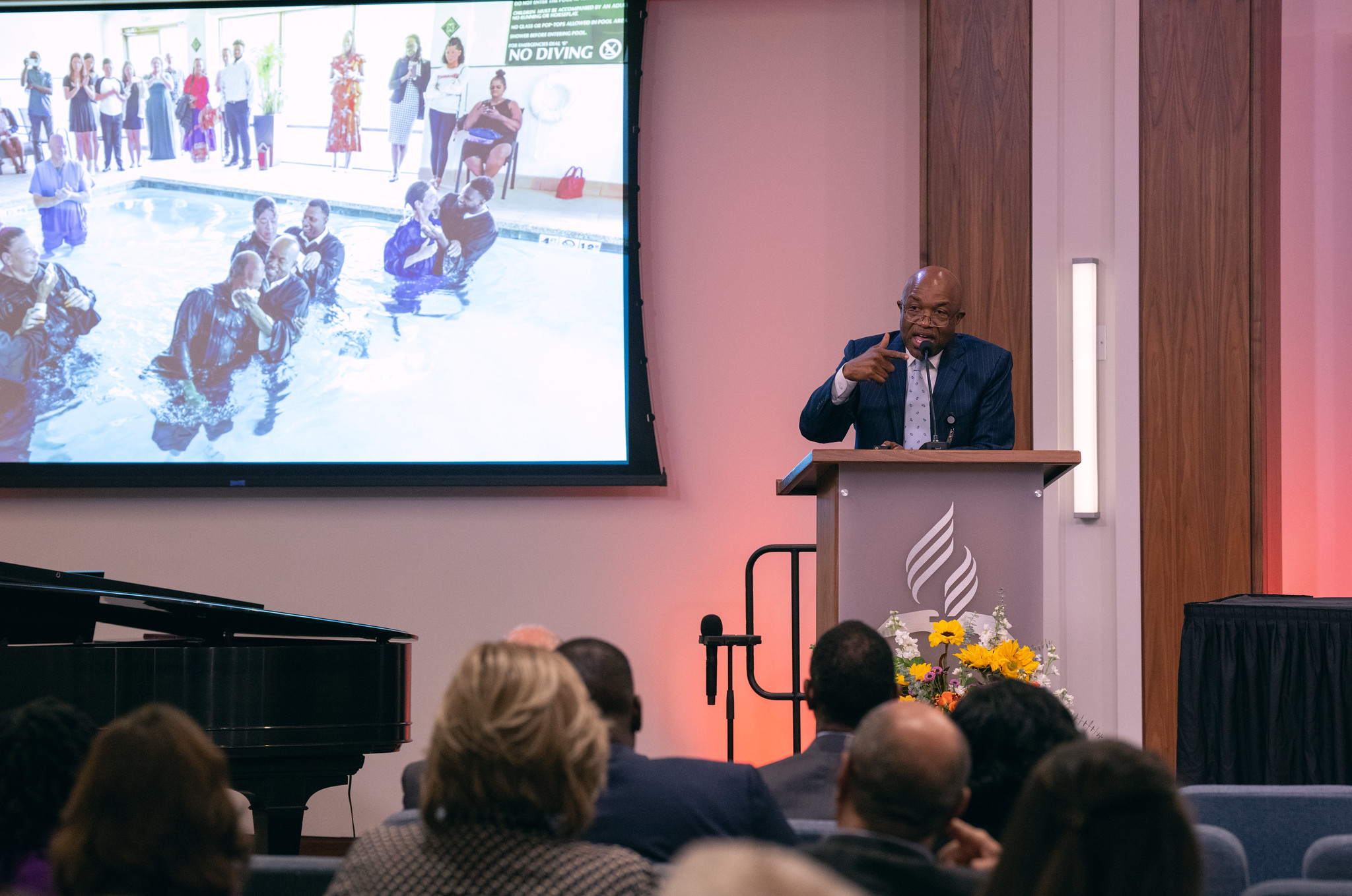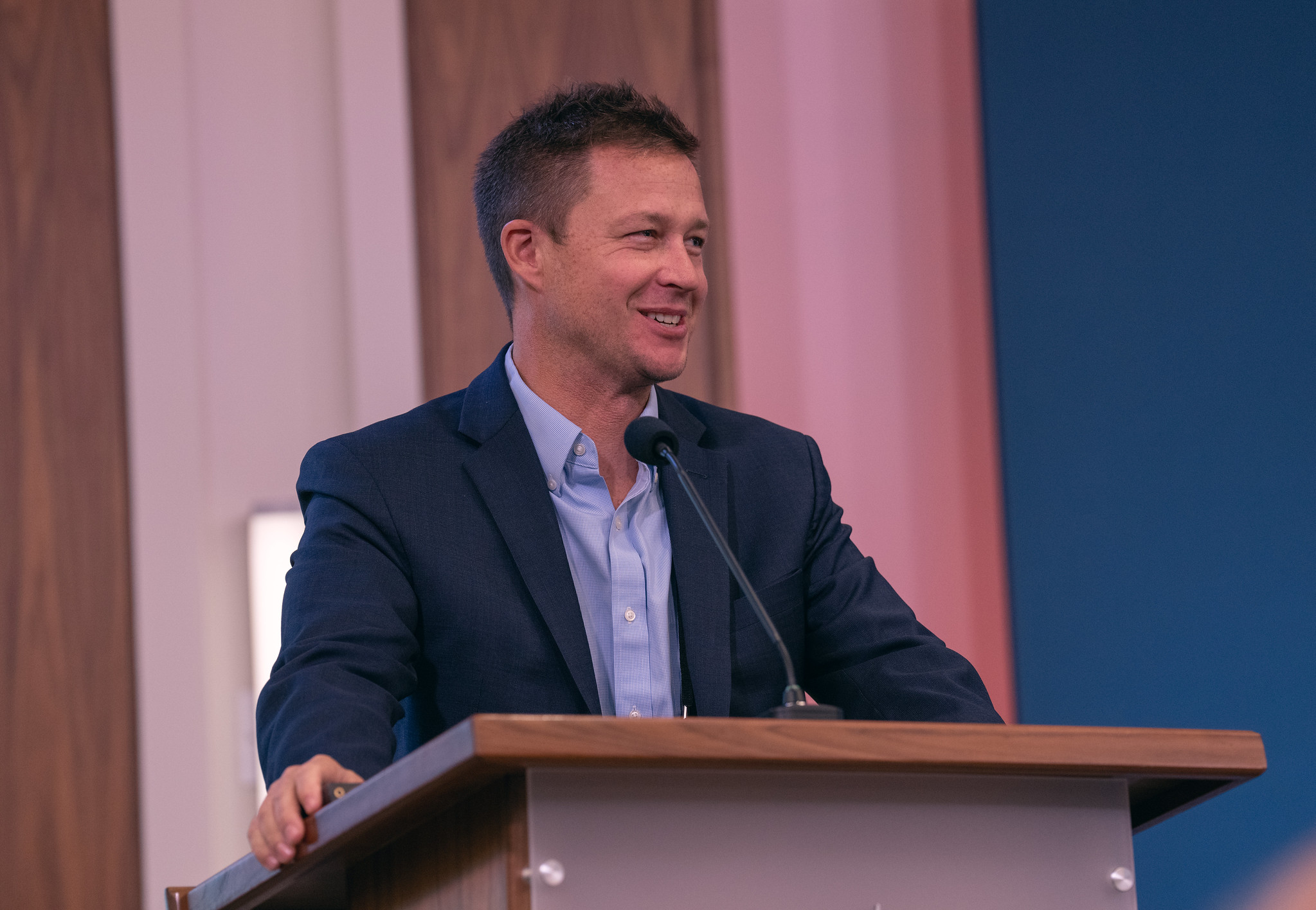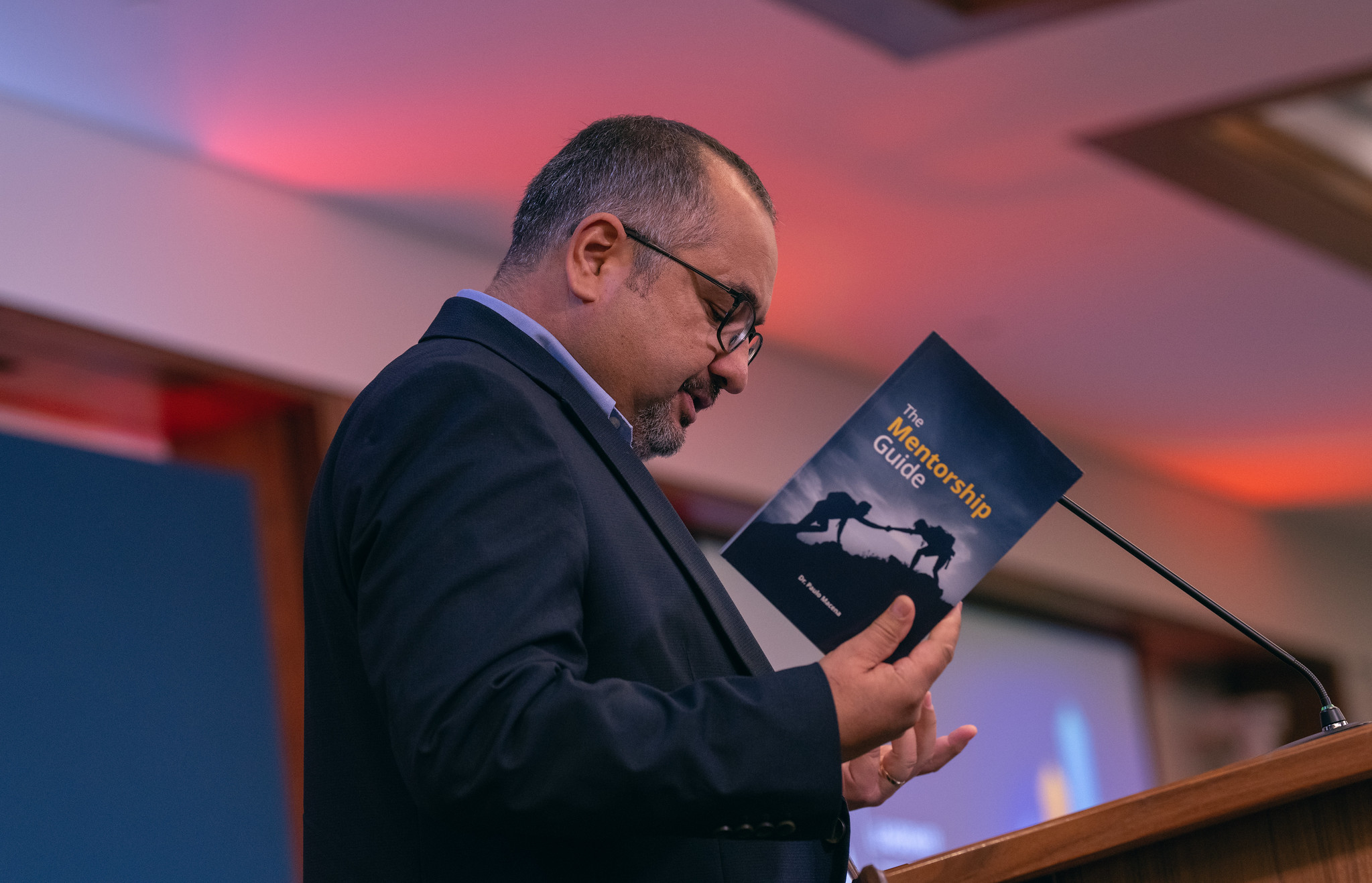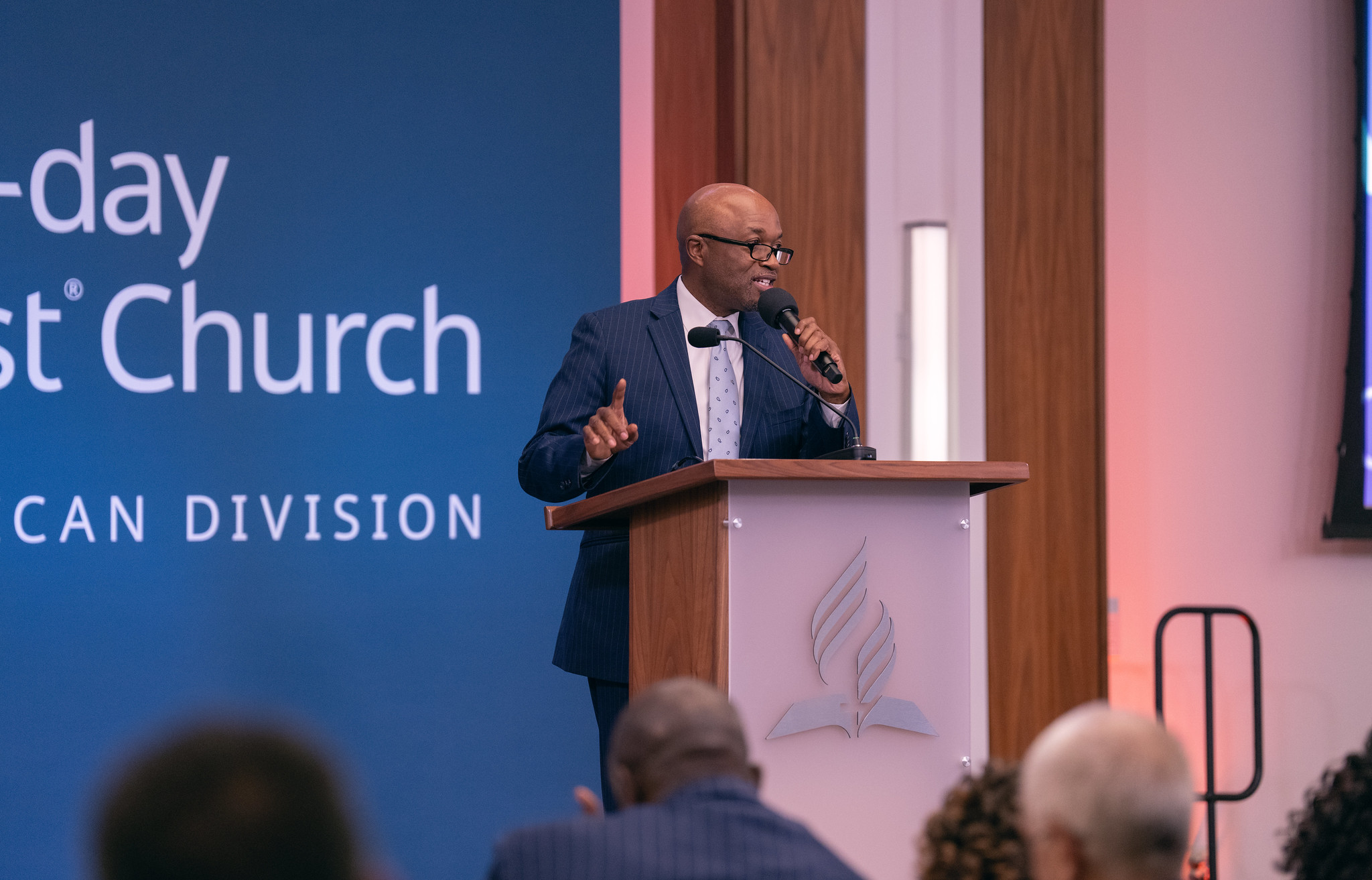
On day two of the 2023 NAD Year-End Meeting, G. Alexander Bryant, NAD president, as part of his YEM report, talks about an evangelism series in Springfield, Missouri. Photo by Pieter Damsteegt
At the North American Division (NAD) headquarters in Columbia, Maryland, the 2023 NAD Year-End Meeting started at 3 p.m. on Thursday, Oct. 26. This annual business meeting, which has returned to an in-person event, with livestreaming on the NAD website, Facebook and YouTube, will provide the opportunity for close to 300 executive committee members to receive reports, amend policies, strategize, and fellowship with church leaders who have dedicated themselves to sharing with others Christ and the Adventist faith.
“God had called us to lead and our assignment is to serve in a very interesting time in history,” said G. Alexander Bryant, NAD president, as he began his 2023 report — his words a continuing thread from his “built for this moment” report in 2022. “With the backdrop of what is happening in the world, I ask, ‘What is God calling us to do in this moment?’”
Bryant reminded those gathered that the group voted the theme “Together in Mission” in 2021 in order to find ways to better and more effectively collaborate together.[1] The hope is that the church in North America continues to explore the intersecting points of what we do so we are more effective, more powerful, and more impactful in our ministry when we do them together, instead of doing them in silos. Those key intersections, said Bryant, are the focus points of media, multiply, and mentorship.
“The question is: Can we look at ways that we can better collaborate together and move the mission of God forward in a more effective way and a more impactful way within these three areas? That’s what we’ve been trying to do over the past two years,” Bryant said, diving into the first focus of media through a short introduction before welcoming Adam Fenner, Adventist Learning Community (ALC) director and newly elected vice president for digital media, to participate in the report.

Adam Fenner, Adventist Learning Community director and new NAD vice president for digital media, talks about how the NAD and its members can occupy the digital space, during the YEM president's report on Oct. 27, 2023. Photo by Pieter Damsteegt
Media and Digital Assets
Fenner talked about how people live in a digital reality, saying that one-third of the population in Canada and the U.S. are online at all waking hours. “If people are going to be online, we need to be there. We need to be there very intentionally and in very meaningful ways. We are Christ's ambassadors,” he said. Fenner described ALC’s three new curricula designed to help our church members be intentional about digital ministry — Faith Made Social; Discipulos Digitales; and Empty Views to a Million Views Master Class. The hope is that this training will help members become digital disciples. “If they're going to be online, why not share Jesus and represent Jesus and His church in a meaningful fashion?” Fenner reiterated while explaining that the curriculum offers training for different member groups, including youth and young adults, Spanish language speakers, and evangelists and church employees.
Fenner also shared that NAD Multilingual Ministries has developed a number of resources. “To give you an idea of how much demand there is for this, right now we have 7,000 committed people training, actively dealing with some of our challenges, and becoming a digital evangelists for our church and for Jesus,” Fenner concluded.
Bryant underscored that the training of 10,000 digital disciples, part of the media focus revealed in 2021, is well under way; and next steps will be strategic use of various social media platforms with content to be developed and shared.
The Digital Touch
Bryant continued in the media focus by updating the executive committee on advances that Adventist Information Ministry (AIM), located on the campus of Andrews University, has been making and will continue to make as the ministry repositions and refocuses in the digital space. For many years AIM has been a phone call center providing member care while supporting the church’s media ministries. And while that ministry will continue, with another campus opening up on the campus of Walla Walla University to provide better service to west coast constituents, AIM’s care will expand to websites and social media.
Other highlights included the mention of a partnership in the works with the General Conference to provide content and follow up on the interest that Adventist.org generates geared toward the many North Americans who visit the site. “What we found is that about 70 percent [of those who visit Adventist.org] are in the NAD territory — and of that 70 percent, about 70 percent are Gen-Xers and Millennials,” stated Bryant. “What they’re looking for is not just history; they’re looking for values and biblical truth. What an opportunity! They are coming to us to find out what we believe, what our values are, and the truths that we share.”
Bryant mentioned the work that professional services has provide in creating social media campaigns and content that reflects the NAD brand. He concluded with sharing the news of the start of the nadAdventist.org redesign and expansion to provide easier access to all the division’s resources.

Paulo Macena, NAD director of leadership development, shares information about the NAD's leadership program at the 2023 NAD Year-End Meeting. Photo by Pieter Damsteegt
Leaders Need Mentors Too
The focus of mentorship was next in Bryant’s report. He shared the startling statistics that since January 2021, at the division, two of three of the NAD’s officers are new,[2] five of six vice presidents are new, and nine department directors are new. At the union level, five of nine presidents are new, and seven executive secretaries are new. Looking at the conference level: 42 of 59 conferences have new presidents; 43 new executive secretaries; and 18 new treasurers. Bryant also delved even further, talking about the many new educational and youth leaders throughout the unions and conferences. “One of the most significant areas we have addressed is leadership development,” he said, and he introduced Paulo Macena, NAD director of leadership development, to share a portion of the report.
Macena explained that both a new mentorship guide book was published and a mentorship program was started in the past year. These are resources to help train current leaders to be mentors — and for current yet more seasoned leaders to mentor new leaders. Macena reported that there are about 35 conference presidents enrolled in the mentorship program with four mentors — Rick Remmers, NAD assistant to the president; Ken Denslow, Lake Union president; Ricardo Graham, retired Pacific Union president; and Fredrick Russell, pastor and founder of True North Leadership Group — who meet periodically with the presidents. Plans are to expand this to conference secretaries, treasurers, and other department leaders.
Explained Macena, “Leadership has to do with engaging, networking, and using the gifts and talents that God gave us in order to help others. … It is important to take the time to mentor.”
“The intention is to have this [training program] was a model for every leader in every level of the church,” added Bryant before pivoting to the third focus, multiply. “The leadership certification program will be ongoing to provide resources, seminars, and interaction for continuous learning and continuous development.”

G. Alexander Bryant gives his 2023 president's report at the NAD Year-End Meeting. Photo by Pieter Damsteegt
The Multiplication Factor
Bryant talked about several key areas that can help grow the church exponentially through a myriad of ministries that include building relationships, praying, educating, and healing. He first mentioned church planting; second was centers of influence in urban areas; and third was public evangelism. The latter two are aspects of the Antioch initiative, which centers on the engagement of all church members, and the leveraging of resources especially in places where the population is high. The goal is to add 50,000 disciples in our cities to serve in churches, in schools, with indigenous Americans, with immigrant groups, in centers of influence, as student missionaries in metropolitan areas, in community service, and more. It is finding out what the needs are and aggregating “our resources to come in and help in particular projects,” said Bryant.
Bryant shared alarming projections mentioned by Pew Research in several studies. In 1972, 90 percent of the United States claimed Christianity for their religion. In 2020, 64 percent made that same claim. If the trend continues, by 2070 the drop may be to 35 percent. He talked about the increase in “nones,” those who have no religious affiliation whatsoever, going from about five percent in 1972 to 29 percent in 2020 in the surveyed age groups, according to the Pew Research Center and the General Social Survey. Finally, Bryant turned his attention to the numbers for younger Americans, adults under age 40. In 2020, 65 percent of this age group is less likely to become or remain Christian. “Any way we slice this up, it tells me that we have to think carefully about how we do evangelism and what we’re using to try to attract people who do not have the same Christian foundation or Christian values as we do,” he concluded. “We need to reach people while they are still young. … We have AIM, we have Message magazine, we have Adventist Learning Community, we have AdventSource … we have our schools, conferences, health systems, universities, evangelism training center, retreat centers, camps … we should be able to do something. We should be able to bring all these resources to bear to make even greater impact for Christ.”
Bryant shared that one way we can all work together is through initiatives such as Antioch. “What would happen if division, union, and local conference resources ‘collide’ in one place at one time? Put all the resources we have into one or two cities for a couple of years and see what happens? I believe the Lord can do something special. Intentional and systematic mentorship for every level of the church. All or our media ministries working together. Centers of influence providing healthful eating alternatives, exercise classes, food distribution, counseling services, computer training,” he said, imagining how working together would create these synergies that would transform into providing for needs and bringing people to God.
“That is the message the Lord gave the Seventh-day Adventist Church though His servant Ellen White. I tell you today that we are not too late. It’s not too late to take the message that God has given us to another level.”
Dreams into Reality
As the president’s report drew to a close, Bryant encouraged those listening. “We talked about those statistics, about the ‘nones’ and those unaffiliated and the challenges that we have in the time that we're living in. The great equalizer is the Holy Spirit,” Bryant declared. “When Jesus started His church they didn't have institutions. They didn't have buildings. They didn't have mentorship programs. They didn't have media. … The one thing that they had was the Holy Spirit. And [Jesus] said, ‘The Holy Spirit, whom the Father will send in my name, will teach you all things and will remind you of everything I have said to you’” (John 14:26, NIV).
Bryant shared about the late summer evangelism series he spoke at in Springfield, Missouri, the place he started his ministry 40 years ago. “We started this meeting at a Holiday Inn and people came and they kept coming.” He explained that it used to be a predominately African-American community and the team sent out flyers, but 97 percent of the respondents to Bible studies were Caucasians. With concern, the Bible study person called Bryant.
“Are they letting you in the house?" asked Bryant.
The Bible worker replied, “Yes."
"Were they taking the Bible studies?"
“Yes,” was the answer.
"Well,” said Bryant, “keep going. Just keep going."
Bryant related that the people who attended the meetings said with tears that they “didn’t know that there were people like you all.” After the series, which was supported by local Adventists, three joined the church by profession of faith, and 19 people were baptized, including Bryant’s 14-year-old great-niece and seven other members of his family.
There were four members at that small Springfield church. Now they have 25 to 30 people coming every Sabbath.
“The reason I wanted to go [there] is because we think those places are hopeless. We think it's too hard and too tough. But God says, ‘I have people everywhere. I just need somebody to go fishing.’”
After quoting Joel 2:28, Bryant finished his report, “The world church calls it TMI — total member involvement — global TMI. Let's challenge every member to get involved in the mission Jesus has called us to. Everyone can do something.”
[1] The NAD executive committee voted in February 2021 to focus on the three areas of media, multiply, and mentorship.
[2] If one were to go back to July 2020, all three of three officers at the division are new to their positions.
